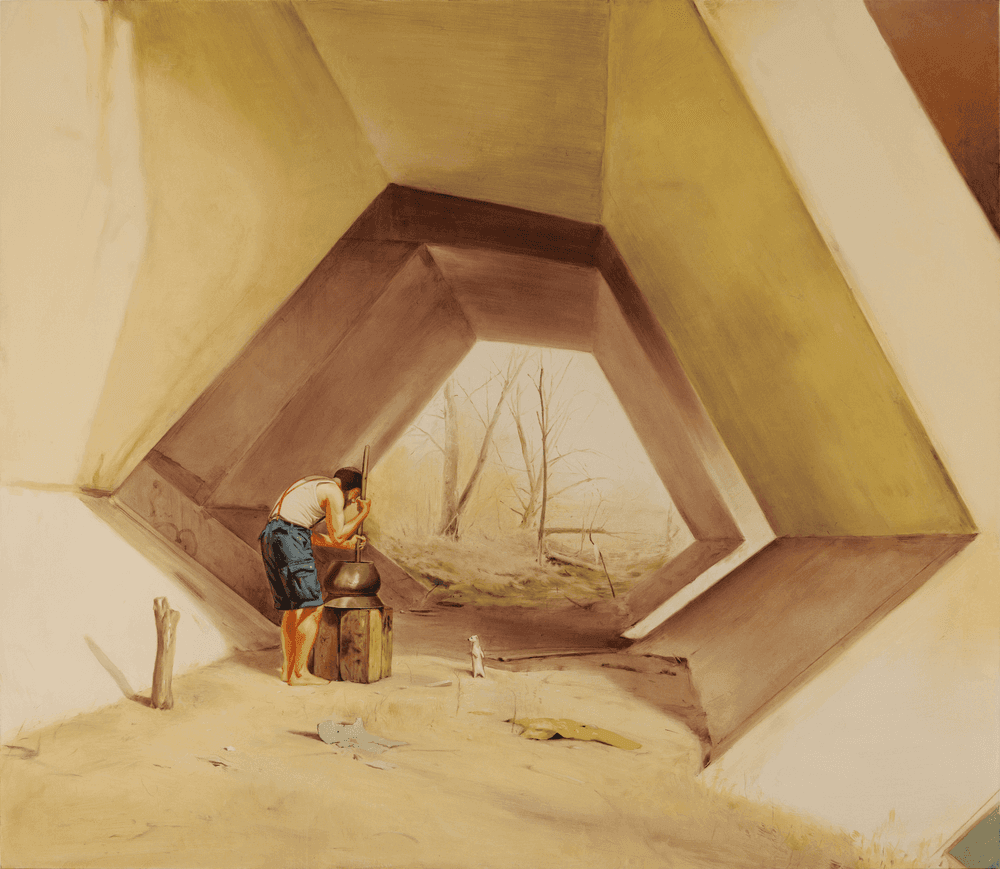QUEM GENUIT ADORAVIT
Manuele Cerutti

In Collezione Maramotti’s Pattern Room, Turin-based painter Manuele Cerutti is presenting QUEM GENUIT ADORAVIT, a new group of paintings and works on paper developed specifically for this original project.
Drawing inspiration from simple, yet intense personal experiences – fatherhood, and the first few years of his son’s life – Cerutti depicts the generation of an entity that unexpectedly takes on childlike attributes: an unconscious, almost involuntary creation informed by the vegetative experience of plants and (in the tradition of alchemy) minerals.
For years now, this artist has been giving painted form and performative presence to the ordinary objects – sometimes mutilated or fragmented, always stripped of their original function – that fill his studio: an old coffee pot, twisted sticks and tubes, bits of plastic, chicken bones, stools, palettes, buckets and jars of all kinds. They take on central roles in “unstill lifes” where details from the everyday world, recomposed in new ways, become expressions of a suspended, primal, even sacred time.
A recurring image in the exhibition is a piece of black plastic landscape fabric knotted around the leg of the human figure who appears in the works. Almost a natural extension of his body, this binding alludes to marcotting, or layering: a technique that creates new plants by encouraging root growth at some point in the stem or branch of the original one.
This method of asexual propagation, achieved by detaching part of the parent’s body, ties into the artist’s allegorical, mythological exploration of parthenogenesis, a type of reproduction in which the egg cell develops without fertilization. Amid echoes of the miraculous, even monstrous births found in ancient myth, the individual at the centre of Cerutti’s story in images bears the features of the artist, subjected to a process of constant examination and multiplication that ultimately transforms them into a universal figure.
The subject of these works is plagued by an incurable wound in his leg: a part of himself that he delicately wraps in the fabric, a fertile injury that he endlessly nurses, an unexpected point of germination that buds into other lives and paths. This archetypal figure does not fit the definition of a contemporary hero. Rather, he embodies a deviation from the canon, an interruption in linear development, evoking a sense of inadequacy and fragility. An element out of balance – often suspended within pictures so sophisticated and detailed that they seem real – he attempts, through a series of actions, to assimilate the child’s form of knowledge, recognizing that asymmetrical movement is a possible way forward.
The territory he travels through, moving beyond the studio, is the landscape on the outskirts of Turin: places the artist knows well, pervaded by entropy, where the city overlaps with the countryside, rivers flow under flyovers, industrial ruins mingle with empty fields and a concrete underpass can be magically transformed into a huge portal straight out of a sci-fi story.
But Cerutti’s realm of exploration is first and foremost painting itself, which he calls “a continual imprinting of action.” Whether it is the subject that summons up its own vivid apparition on the canvas, or the painting process, with its layers, glazes and erasures, that makes way for the composition it underpins, one finds an endless investigation into the language of this medium that reverberates through the key figure’s journey. Through engagement and detachment, achievements and failures, attempts at reclamation and acts of renunciation, it is a movement towards the formation of an inexpressible attachment (which the exhibition title refers to: “She worshipped the one she bore”). And in it, one may stumble into awe, creating new relationships with existence.
The catalogue published in conjunction with the exhibition will feature texts by sociologist Gian Antonio Gilli, by poet and writer Valerio Magrelli and by Elena Volpato, curator and conservator at GAM - Galleria Civica d’Arte Moderna e Contemporanea in Turin.






Title: Manuele Cerutti. QUEM GENUIT ADORAVIT
Texts by: Gian Antonio Gilli, Valerio Magrelli, Elena Volpato
Publisher: Silvana Editoriale, Cinisello Balsamo, Milan
Year: 2024
Number of pages: 112
Dimension: 23 x 28,5 cm
Languages: Italian / English